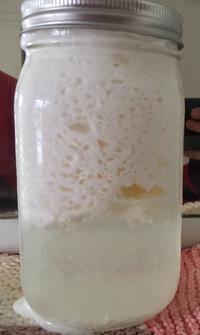
 4
4




John Hutter wrote:Fermenting green tomatoes with chilies is something I've done for 4 years now, with 20 or so pounds of green tomatoes and 10 pounds of chilis, come autumn frosts. After it ferments for about 8 weeks, I puree it, pour it into 10 or 12 quart jars and put them in the freezer to eat year round. Remove a jar from the freezer and add some allium, cumin and coriander to taste. It's a little too sour to eat like a salsa with chips I think, but honey or shredded carrot or something can fix that. I usually cook with it. Mash it up with avocado and it's like the best guacamole ever.
To lead a tranquil life, mind your own business and work with your hands.




 4
4




Julie Bernhardt wrote:I dont have access to whey but I want to try a bean ferment.
Do you think I could just add some store bought miso paste instead?
I always wanted to make my own miso but I couldnt find the koji. I have looked at local Asian stores and online but no luck. I suspect it was probably there, labled in Japanese.
"We're all just walking each other home." -Ram Dass
"Be a lamp, or a lifeboat, or a ladder."-Rumi
"It's all one song!" -Neil Young
 4
4




Dave's SKIP BB's / Welcome to Permies! / Permaculture Resources / Dave's Boot Adventures & Longview Projects














 2
2




 3
3




Gail Jardin wrote:Is there a separate forum for home brewing?
Dave's SKIP BB's / Welcome to Permies! / Permaculture Resources / Dave's Boot Adventures & Longview Projects














 2
2




 2
2




Julie Bernhardt wrote:
Doesnt using canning lids and bands that way cause yours to rust?
Dave's SKIP BB's / Welcome to Permies! / Permaculture Resources / Dave's Boot Adventures & Longview Projects














 1
1




 2
2




Julie Bernhardt wrote:I know when I open the lid there is some clear liquid on top, probably a teaspoon.
That is the liquid your refering to, right?

Julie Bernhardt wrote:
Can I save that in a seperate container a day or 2 till I open more containers and get enough to make the recipe? Or would it die?
Dave's SKIP BB's / Welcome to Permies! / Permaculture Resources / Dave's Boot Adventures & Longview Projects














 3
3




Julie Bernhardt wrote:Thank you!
I will use yogurt.
Doesnt using canning lids and bands that way cause yours to rust? I have to keep mine bone dry as soon as they are done being used for prosessing or they rust and become very hard to remove ffom my jars.
I do use old bands with a paper coffee filter over ferments, but I dont allow the contents of the jar to come in direct contact with it.
Idk, the black discoloration and rust probably doesn’t contaminate the food but I was never sure about that. I switched over to Tattler lids but still have to be carefull with the bands.

Julie Bernhardt wrote:I know when I open the lid there is some clear liquid on top, probably a teaspoon.
That is the liquid your refering to, right?
"We're all just walking each other home." -Ram Dass
"Be a lamp, or a lifeboat, or a ladder."-Rumi
"It's all one song!" -Neil Young
 1
1





 6
6





 2
2




High quality probiotic cultures specializing in kombucha cultures and water kefir grains that grow like gangbusters. Check out the March special how to get free water kefir grains. Kefirlady.com
 2
2




Leila Rich wrote:
it is fermented bean crack, I tell ya!Judith Browning wrote:I am absolutely addicted to the fermented bean dip recipe that I posted on the first page of this thread
Hmm, that came out wrong...anyway, it's great-especially with boiled eggs and stuff.
I've only made it with beans- red and white, mind you
I haven't tried it with another grain/legume/pulse-I bet it would be great though!




Rio Rose wrote:
Leila Rich wrote:
it is fermented bean crack, I tell ya!Judith Browning wrote:I am absolutely addicted to the fermented bean dip recipe that I posted on the first page of this thread
Hmm, that came out wrong...anyway, it's great-especially with boiled eggs and stuff.
I've only made it with beans- red and white, mind you
I haven't tried it with another grain/legume/pulse-I bet it would be great though!
I just made this with black beans...you had me at fermented bean crack! I added Serrano peppers but otherwise followed the recipe exactly. First taste of the mix I thought it was too salty, but by day three it was incredible. Very Kim-chi meets creamy beans. I have more beans soaking already, because that first batch is going down fast. Thanks so much for sharing.
"We're all just walking each other home." -Ram Dass
"Be a lamp, or a lifeboat, or a ladder."-Rumi
"It's all one song!" -Neil Young
 1
1




Judith Browning wrote:I haven't made that dip in awhile...glad for the reminder! I've got some nice black beans and can get a little whey from some yogurt, grey salt...so simple and tasty. and onions! did you add any spices in the ferment?








ripon hassan wrote:Here in India, there is popular traditional dessert called jalebi is made by using this lacto - fermentation method.
Yoghurt is mix with all purpose flour and make a dough by adding little water. Cover and keep overnight at room temperature
Whathever you are, be a good one.
___________________________________

|
The moustache of a titan! The ad of a flea:
The new kickstarter is now live!
https://www.kickstarter.com/projects/paulwheaton/garden-cards
|
